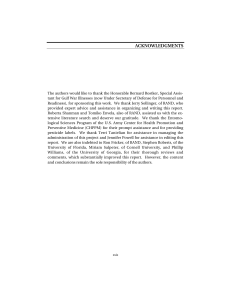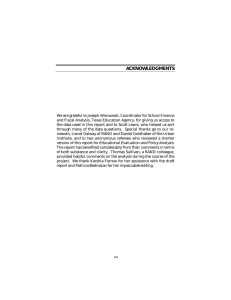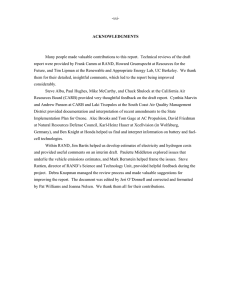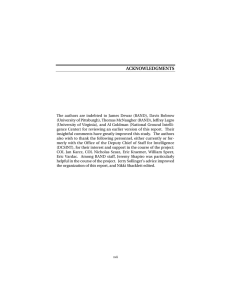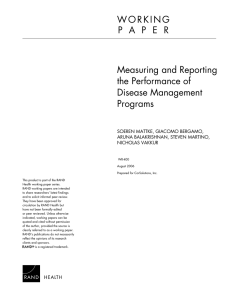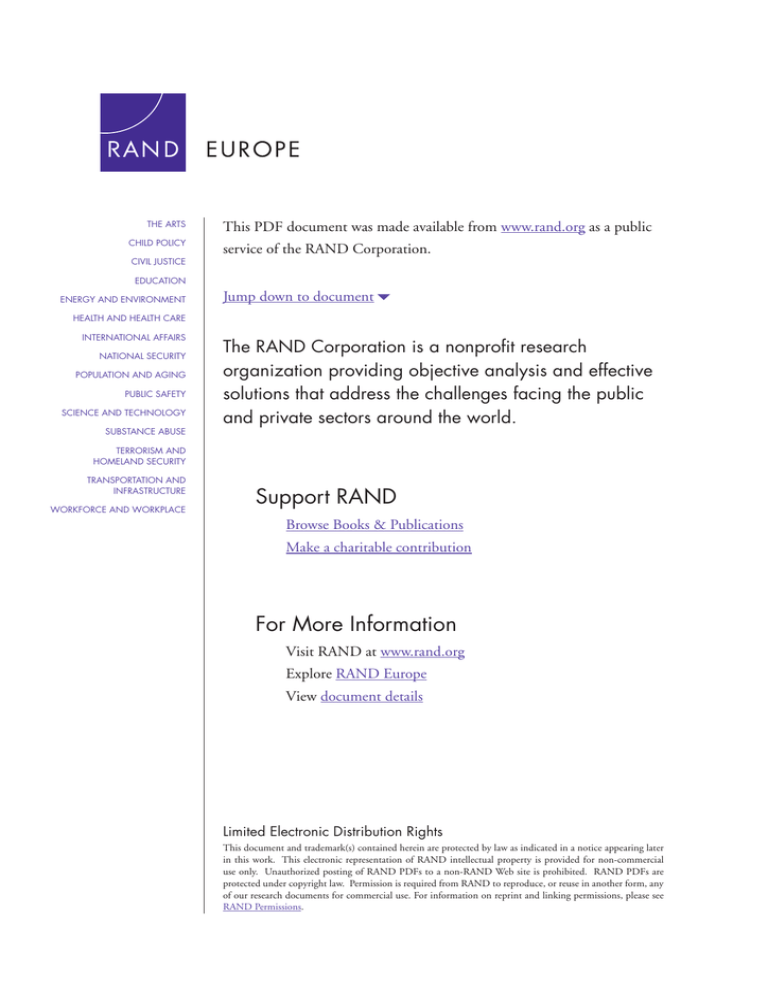
THE ARTS
CHILD POLICY
CIVIL JUSTICE
This PDF document was made available from www.rand.org as a public
service of the RAND Corporation.
EDUCATION
ENERGY AND ENVIRONMENT
Jump down to document6
HEALTH AND HEALTH CARE
INTERNATIONAL AFFAIRS
NATIONAL SECURITY
POPULATION AND AGING
PUBLIC SAFETY
SCIENCE AND TECHNOLOGY
SUBSTANCE ABUSE
The RAND Corporation is a nonprofit research
organization providing objective analysis and effective
solutions that address the challenges facing the public
and private sectors around the world.
TERRORISM AND
HOMELAND SECURITY
TRANSPORTATION AND
INFRASTRUCTURE
WORKFORCE AND WORKPLACE
Support RAND
Browse Books & Publications
Make a charitable contribution
For More Information
Visit RAND at www.rand.org
Explore RAND Europe
View document details
Limited Electronic Distribution Rights
This document and trademark(s) contained herein are protected by law as indicated in a notice appearing later
in this work. This electronic representation of RAND intellectual property is provided for non-commercial
use only. Unauthorized posting of RAND PDFs to a non-RAND Web site is prohibited. RAND PDFs are
protected under copyright law. Permission is required from RAND to reproduce, or reuse in another form, any
of our research documents for commercial use. For information on reprint and linking permissions, please see
RAND Permissions.
This product is part of the RAND Corporation documented briefing series. RAND
documented briefings are based on research briefed to a client, sponsor, or targeted audience and provide additional information on a specific topic. Although documented
briefings have been peer reviewed, they are not expected to be comprehensive and may
present preliminary findings.
Motivations and Attitudes
of New Recruits Regarding
Remuneration Issues
Focus Group Investigation and
Analysis
Hans Pung, Laurence Smallman, Michael Hallsworth,
Samir Puri, Jennifer Rubin
Prepared for the UK Ministry of Defence
The research described in this report was prepared for the UK Ministry of Defence.
The RAND Corporation is a nonprofit research organization providing objective analysis
and effective solutions that address the challenges facing the public and private sectors
around the world. RAND’s publications do not necessarily reflect the opinions of its
research clients and sponsors.
R® is a registered trademark.
© Copyright 2007 RAND Corporation
All rights reserved. No part of this book may be reproduced in any form by any electronic or
mechanical means (including photocopying, recording, or information storage and retrieval)
without permission in writing from RAND.
Published 2007 by the RAND Corporation
1776 Main Street, P.O. Box 2138, Santa Monica, CA 90407-2138
1200 South Hayes Street, Arlington, VA 22202-5050
4570 Fifth Avenue, Suite 600, Pittsburgh, PA 15213-2612
Westbrook Centre, Milton Road, Cambridge CB4 1YG, United Kingdom
RAND URL: http://www.rand.org
RAND Europe URL: http://www.rand.org/randeurope
To order RAND documents or to obtain additional information, contact
Distribution Services: Telephone: (310) 451-7002;
Fax: (310) 451-6915; Email: order@rand.org
Summary
This document, prepared for the Service Personnel (Policy) (SP(Pol)) Directorate within
the UK Ministry of Defence (MOD), presents key findings and trends from a series of
focus groups which RAND Europe conducted at a tri-Service level. The objective of this
work is to better understand the views of new recruits of the pay and allowance package
provided by the MOD and to identify trends for further analysis.
Within the context of this project, the MOD wished to examine six key issues relating to
the overall remuneration scheme. They are:
•
Recruitment drivers and motivations
•
Comparison of training expectations with experience
•
Advantages/drawbacks to being in the Armed Forces
•
Career aspirations and the role of remuneration
•
Satisfaction with the current remuneration package
•
Motivational utility of operational pay package
Key Perceptions/Findings
After analysing the responses of focus group participants in light of the project objectives,
a number of key findings stand out. While we examine these in greater depth later in this
report, a summary follows:
•
Other factors than the remuneration package more directly impact recruitment:
When examining why people joined their respective Service, the focus group
participants rarely cited remuneration reasons as direct factors for joining the Armed
Forces. Other factors, such as lifestyle and family/colleague experience, appeared to
be more directly relevant. However, pay and allowances may indirectly impact
recruitment through their influence on perceptions of Service life or experiences of
former Service members (who, in turn, influence others to join the military).
•
New recruits are generally positive about their chosen occupation and
opportunity of a career: Factors such as service camaraderie, lifestyle, and pride in
themselves and what they have undertaken combined to create a positive view of
service life. Negative factors were focussed on the immediate training environment,
with few recruits voicing significant concerns about their post-training situation.
Remuneration issues were not explicitly mentioned. Additionally, the majority of our
respondents expressed a desire to serve for significant periods of time, many through
a full career.
vii
Motivations and Attitudes of New Recruits Regarding Remuneration Issues
RAND Europe
•
Most new recruits are still evaluating their remuneration package: Although
there was no salient view, a slight majority of the respondents were more positive or
ambivalent about the package and there was an expectation that it will improve once
they leave initial training. Others responded that they had made a deliberate decision
to join the Armed Forces for reasons unrelated to financial compensation. One area
of the remuneration package which stood out as being positive was that of the
benefits, although there seemed to be a variable understanding that these benefits
made up a portion of the remuneration package.
•
Pay is only one important factor (of many) in the decision to remain in the
Armed Forces: Although pay and promotion prospects (to include its monetary
benefits) are important factors to consider in the decision to stay in the military, there
are a number of intangible non-remuneration issues, such as family concerns, career
opportunities, and quality of life which appear to play at least as important a role as
remuneration factors in this decision. Thus, a holistic approach toward retention
incentives appears to be the most effective way to convince Service personnel to stay
in the Armed Forces.
•
House purchase is important to new recruits, but the motivation behind this
remains unclear: Our respondents overwhelmingly commented on the value of
purchasing a home, although the motivation behind this desire was less apparent.
Many respondents both recognised the value of ‘getting on the property ladder’ and
expressed a desire to ‘buy-to-let’, although the intersection of these two groups is
uncertain. However, there was some concern about the salary-house cost disparity.
•
The views of new recruits are similar to those of longer-serving Service
personnel: As will be shown later in the report, we did not find significant
divergence between the views of new recruits and longer-serving personnel. Although
new recruits are more focussed on their immediate training environment, their views
generally coincided with their longer serving peers regarding motivation to join the
Forces, drivers of retention, dislike of disruption (particularly concerning families),
and the positive impact of the introduction of operational pay.
Focus Group Methodology, Conduct, and Composition
For this project, we used focus groups as the method to capture Service member
perceptions about their remuneration package. Focus groups are a qualitative research
method where multiple groups of individuals are asked to discuss a topic to gain insights
into their perceptions and attitudes. Questions are asked in an interactive group setting
where participants are free to talk with other group members.
During a four-week period at the end of November and beginning of December 2006,
we conducted twenty-six focus groups with MOD Service personnel at seven locations in
viii
RAND Europe
Summary
the UK.1 Within each site, groups were divided by rank structure,2 in order to provide
an environment where participants felt comfortable sharing their candid comments. This
structure also allowed them to focus on issues and areas that most affected them.
Overall, 220 new recruits participated in twenty-six groups. Each of the focus groups
lasted between 70 and 90 minutes. The semi-structured protocol allowed the project
team to guide the groups and so ensure that their discussion was consistent and also
flexible and dynamic. A facilitator led the focus groups while another member of the
project team took notes of the session. The note takers attempted to capture the essence
of the discussion and used the participants’ own words to the greatest extent possible.
After completion of the groups, we summarised the sessions and entered the data into a
software package designed to assist in data analysis. By being able to look at responses
both across all sites, but also within rank or Service groups, we were able to determine
which perceptions were salient to their respective groups. The salience of responses is the
crucial factor when identifying key trends across the various focus groups. Salient
responses are those that occur across a majority of the groups and, thus, can be taken to
be more representative of the groups’ views than those responses that only occurred in
one or two groups.
The question protocol that we used can be found in Appendix A of this report; further
focus group demographic information can be found in Appendix B.
Focus Group Perceptions
When asked what made them interested in the Armed Forces, group participants
provided two reasons that were salient across the groups. A family history or experience
with the military as well as lifestyle opportunities (such as sport, adventure, exciting
opportunities) were the reasons given across all groups. However, all groups also stated
that a positive perception of Service life within the Armed Forces as well as the
opportunities that it could provide were the factors which actually encouraged them to
join the Forces. Many participants within the focus groups considered other Services
when joining, and this was particularly true for officers.
When comparing their expectations of Service life to their current experience, there was
no consensus regarding how well they had been prepared for life in the Armed Forces.
Information provided by Armed Forces Career Officers was variable, and some new
recruits seemed surprised by the structure and challenge of military training. There was
great variation between those who felt training was more difficult than expected, about
the same as expected, or easier than expected.
1
The sites visited were: RAF Cranwell, RAF Halton, RMA Sandhurst, Catterick Barracks, CTC Lympstone, HMS
Raleigh, and BRNC Dartmouth.
2
The rank groups were Officers and Other Ranks
ix
Motivations and Attitudes of New Recruits Regarding Remuneration Issues
RAND Europe
When looking at positive aspects of being in the Armed Forces, three factors were salient
across all groups: camaraderie within the Services, lifestyle (to include sport and
adventure training), and the belief that they were undertaking a worthwhile occupation.
Within the Services, the Army personnel looked forward to the excitement of their future
jobs as well as the benefits provided by the Armed Forces, a sentiment shared by the
Royal Marines.
Turning to negative aspects of the Armed Forces, the issues of concern centred around
the training environment. Complaints were heard of poor pay during training, lack of
time/freedom, and long working hours. There were also concerns regarding future
disruption which may impact on families.
When looking at factors which provided the greatest influence in deciding to stay in the
Armed Forces, focus group members provided four salient reasons: future family
priorities (which had the greatest consensus), job satisfaction, remuneration (basic pay
and pay upon promotion) and career prospects and promotion opportunities.
There was little consensus around the value and appropriateness of the overall
remuneration package; most new recruits appear to be still evaluating it, particularly the
basic pay. However, it was clear that the allowance package was very poorly understood,
and, in general, focus group participants had a positive view of the Armed Forces benefits
package (such as housing and medical benefits, travel warrants, advances of pay, etc.).
When asking focus groups about their views on the new MOD operational pay package,
the response was generally positive.
There was variability in awareness (and
understanding) of the policy, but other ranks in particular saw the policy change as
positive and encouraging. There was a vocal minority who where more cynical and felt
that the policy was centred on publicity rather than Service member reward.
Finally, when discussing the importance of purchasing a home, two responses were
salient—those who wanted to purchase a home as quickly as possible and those who
wanted a home in order to let it out. However, the intersection in motivation between
these two groups was not possible to measure. In addition, there were those who
expressed concern about how disparities in salary levels and house prices could limit the
ability to purchase.
Comparison to Previous Remuneration Focus Group Work
In early 2006, RAND conducted a similar focus group investigation examining
remuneration issues amongst serving Armed Forces personnel. The need to understand
any potential differences between that demographic and new recruits led to the work
summarised above. However, we also conducted a comparison between the findings of
the two studies to identify areas of alignment and divergence of views.
x
RAND Europe
Summary
Overall, there is considerable convergence between the analysis of new recruits and
longer-service Armed Forces personnel. The greatest alignment is in the following six
areas:
Pay: Overall, there does not appear to be a problem with individual Service member pay.
Although some personnel expressed discontent with their levels of pay, this does not
appear to be representative across all of the focus groups.
Allowances: In both studies, we found wide evidence of either a lack of understanding of
the allowance package or elements of the package which drove unwanted behaviour.
This argues for a simpler, more transparent package where it will be easier to assess its
impact.
Recruitment: In both sets of focus groups, remuneration issues did not appear to be a
direct influence in the decision to join the Armed Forces. Family connections and
lifestyle opportunities appear to be the most directly relevant.
Operational Pay: Although the latest operational pay package did not exist when we
conducted our initial focus group work, there was considerable desire for a monetary
package to compensate Service members on deployment. Now that the package has been
introduced, it appears to have been positively received amongst the new recruits to the
Armed Forces.
Retention: There are a number of factors which impact on the decision of individual
Service members to remain in the Armed Forces when their initial obligation is
completed. Chief among these are family issues, career and promotion prospects, job
satisfaction, and job security. Remuneration issues are represented through both career
opportunities (both inside and outside of the Services) and promotion prospects.
Disruption: Both sets of study participants expressed concern about the degree of
disruption that they and their families did (or were anticipated to) experience. This is an
issue which is important to the group members, and it is important for the Armed Forces
as too much disruption could impact on retention decisions, prompting personnel to
leave the Services.
Although there is much similarity in the findings between the two related pieces of
remuneration work, there are areas of divergence which largely reflect the short-term
perspective which characterised the views of new recruits.
First, there is a heightened emphasis on immediate concerns. Many of the new recruits
were very focussed on issues surrounding the training environment. Thus, quality of life
factors (particularly those to do with training such as free time and dress codes) were
often discussed. Additionally, there was less discussion and understanding around their
allowance package; perhaps because few Service members experienced the fullness of the
allowance scheme while in a training environment.
Second, there was less emphasis on issues which focussed on the future environment.
There was little emphasis on issues associated with “stretch”—frequent deployments,
xi
Motivations and Attitudes of New Recruits Regarding Remuneration Issues
RAND Europe
long working hours, etc., although some participants did discuss future “disruption”
issues, such as time away from family and frequent moves.
We expect that as these new recruits exit their training phase and report to their first
operational units, that such issues will take on a higher profile. However, in the training
environment, they were either superseded by more immediate concerns or had not yet
been experienced.
Finally, we identified a number of areas that require further study on the basis of
questions raised during this series of focus groups and the resulting analysis. By
examining these issues in greater detail, the MOD will be able to better formulate
remuneration policy and improve its impact on the behaviour of Service personnel.
xii

